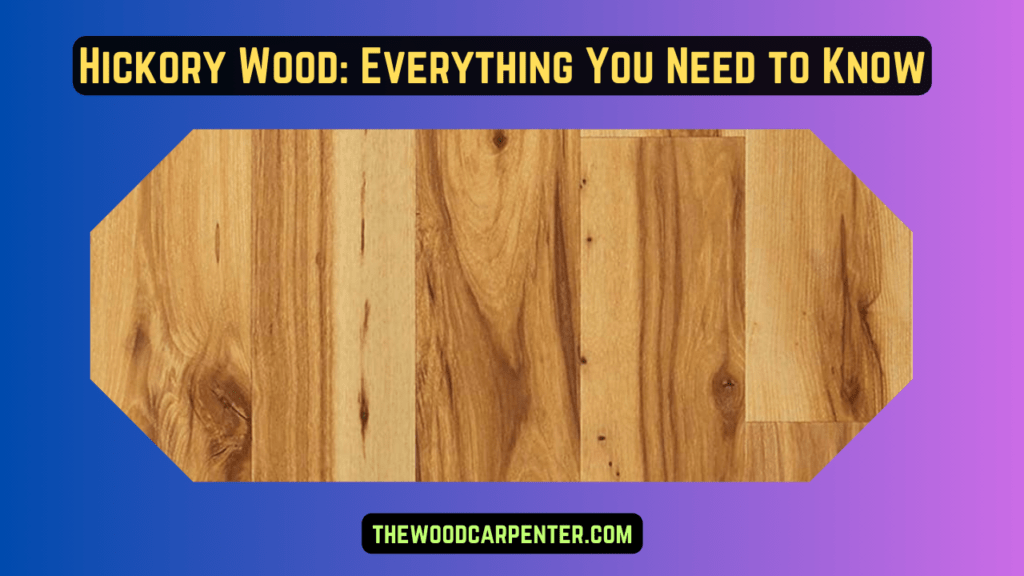
Hickory wood is a strong, durable hardwood that is highly valued for its toughness and unique look. It is very versatile and is used for making furniture, flooring, tool handles, and even high-quality firewood.
This guide will explain everything you need to know about hickory wood, including its features, types, uses, and benefits.
What Is Hickory Wood ?
Hickory is a tough, dense hardwood that comes from North America. It’s known for being strong and resistant to shock. The wood ranges in color from light to medium brown, with some reddish tones, giving it a nice natural appearance whether it is stained or left as it is. The wood grain is usually coarse and straight, with some knots or wavy patterns that add a rustic feel.
Types of Hickory Wood
Several species of hickory are used commercially, each with unique properties:
Shellbark Hickory: Known for large nuts and robust wood, ideal for furniture and flooring.
Mockernut Hickory: Durable and versatile, often used in cabinetry and heavy-use applications.
Shagbark Hickory: Recognizable by its rough, shaggy bark, popular for strong furniture.
Pignut Hickory: Sturdy wood commonly used in tool handles and home fixtures.
There are also fruit-bearing trees like pecan and bitternut hickory, which are not true hickories but provide useful wood primarily valued for their nuts.
Physical and Mechanical Properties
Color: Hickory wood comes in a range of colors, from light beige sapwood to darker, rich brown heartwood. The wood’s natural color changes and its coarse texture make it attractive and perfect for both modern and traditional designs.
Hardness: Hickory is one of the hardest domestic hardwoods, with a Janka hardness rating of 1820. This means it’s very durable and resistant to wear and tear.
Durability: It is very resistant to scratches, dents, and impact damage. While it has some natural resistance to water, its open grain can cause it to shrink or warp if exposed to moisture for a long time.
Workability: Hickory is tough and dense, which can make it harder to work with, but it responds well to steam treatment and doesn’t become brittle.
🛠️ Common Uses of Hickory Wood
1. Tool Handles
Hickory’s shock resistance and strength make it an ideal material for tool handles, including hammers, axes, and shovels. Its ability to absorb impact reduces hand fatigue during use.
2. Furniture and Cabinetry
The wood’s durability and attractive grain patterns make it a popular choice for rustic or country-style furniture and cabinetry. Hickory’s resistance to wear ensures longevity in high-use areas.
3. Flooring
Hickory’s hardness and resistance to wear make it suitable for flooring. However, its susceptibility to moisture changes should be considered, and proper acclimation is essential.
4. Smoking Wood
Hickory imparts a strong, smoky flavor to meats, making it a favorite among barbecue enthusiasts. It’s commonly used in wood chips and chunks for grilling and smoking.
5. Sporting Goods
Historically, hickory was used in the manufacture of baseball bats, golf club shafts, and ski poles due to its strength and shock-absorbing qualities.
✅ Advantages of Hickory Wood
1. Extreme Durability & Hardness
✔ Janka Hardness: 1,820 lbf – Harder than oak (1,360 lbf) and walnut (1,010 lbf).
✔ Resists Dents & Wear – Ideal for high-traffic flooring and work surfaces.
2. Shock-Resistant (Best for Tool Handles)
✔ Absorbs Impact – Preferred for axe handles, hammers, and baseball bats.
✔ Won’t Easily Split – Stronger than most hardwoods under stress.
3. Unique & Rustic Aesthetic
✔ Bold Grain Patterns – Features contrasting light and dark streaks for a natural, rustic look.
✔ Takes Stain Well – Can be finished in light, medium, or dark tones.
4. Excellent for Smoking Meats
✔ Strong, Sweet Smoke Flavor – A top choice for BBQ, ribs, and pulled pork.
✔ Burns Slowly & Evenly – Better than fruitwoods for long smoking sessions.
5. Sustainably Sourced (North American-Grown)
✔ Widely Available – Not an endangered species.
✔ FSC-Certified Options – Eco-friendly harvesting available.
Also read: Herringbone Flooring: Why Everyone’s Choosing It
What Makes Jarrah Wood Stand Out !
❌ Disadvantages of Hickory Wood
1. Difficult to Work With (Blunts Tools Fast)
✔ Hardness Makes Cutting Tough – Requires carbide-tipped blades.
✔ Prone to Tear-Out – Can splinter if not machined carefully.
2. Color Variations Can Be Extreme
✔ Inconsistent Appearance – Some boards are light tan, others dark brown.
✔ Challenging for Uniform Finishes – May need pre-stain conditioner to avoid blotchiness.
3. Expensive Compared to Some Hardwoods
✔ Higher Cost Than Pine or Red Oak – Due to durability and demand.
✔ Labor Costs Add Up – Harder to install (increases flooring/construction expenses).
4. Prone to Movement (Expansion/Contraction)
✔ Needs Proper Acclimation – Can warp if not dried correctly before use.
✔ Not Ideal for Humid Climates – May develop gaps in flooring over time.
5. Heavy & Dense (Hard to Transport & Install)
✔ Weight: 42-52 lbs/ft³ – Heavier than oak or maple.
✔ DIY-Unfriendly – Best handled by professionals.
Hickory vs. Other Hardwoods: Which is Best?
| Feature | Hickory | White Oak | Maple | Walnut |
| Hardness (Janka) | 1,820 lbf | 1,360 lbf | 1,450 lbf | 1,010 lbf |
| Stability | Moderate | High | High | Medium |
| Workability | Difficult | Moderate | Moderate | Easy |
FAQ
1. Is Hickory good for furniture?
Absolutely. Hickory furniture is strong, long-lasting, and has a distinct grain that gives it character. It’s popular in rustic and farmhouse-style decor.
2. Is Hickory wood hard to work with?
Because of its density and hardness, Hickory can be challenging to cut, sand, and finish. Sharp tools and experience are recommended for woodworking with Hickory.
3. Is Hickory a good firewood?
Yes, Hickory is excellent firewood. It burns hot, lasts long, and produces a pleasant aroma, making it ideal for heating and cooking.
4. How do you maintain Hickory wood?
Clean with a damp cloth and avoid harsh chemicals. For floors and furniture, use appropriate wood cleaners and consider occasional polishing or resealing to preserve its finish.
5. Is Hickory wood expensive?
Hickory is generally mid-to-high priced among hardwoods, due to its toughness and attractive grain. It may be more expensive to work with due to added labor in machining

